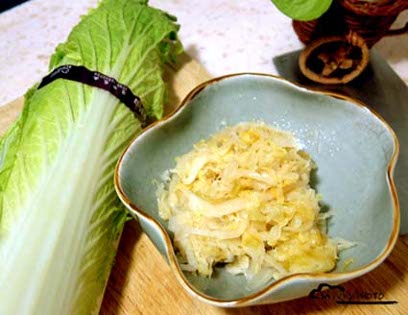Fermentation Workshop Sparks Interest in Ancient Food Preservation Methods
Next week, I am planning to tell you about a workshop we held in Northern Virginia, where we demonstrated lacto-fermentation methods of preserving foods and making beverages. But, a blog reader and her mom who attended the workshop have already submitted a cool recipe and question that I can’t wait to share with you. Sophie’s mom has given up her family recipe for making sauerkraut. Enjoy!
Traditional Chinese Method of Making Sauerkraut
Thank you for the demonstration about sauerkraut. Great that this traditional food will be revived this way. I talked to you briefly about the sauerkraut that my grandma made. You won’t believe it is that easy to make. To be more specific, this recipe is a Northern Chinese sauerkraut, because of different weather conditions, different regions of China have different methods in doing this, although the basics are almost the same.-Sophie
1. choose a stoneware - no metals.
2. clean napa cabbages and put them as a whole in the stone ware, press hard downwards so that there is not much air left between leaves. Add one layer of whole cabbages and one layer of salt, so forth and so on.
3. add water, and put a heavy stone on top of the cabbage to prevent floating.
4. After 1 month, it’s ready to eat. It can be kept 3 or more months at winter room temperature - which is around 50F.
The cabbage leaves or core will not be split or separated. They just press the whole cabbage into the pot.
How much salt is added? I asked my mom but got no answer. In China, we don’t measure while cooking - you might know that. So all is depend on experience: error and trial.
After the long process, we have to cut the cabbage. It will not shred by itself. We usually cook it with fatty pork meat.
Question from Sophie
I read in many places that sauerkraut contains Nitrite, which can cause cancer. Is that true?
Answer:
from Sara Tung, the co-chapter leader of Weston A. Price Foundation in Reston, VA:
Nitrites occur naturally in fermented foods. Nitrites have been found to help preserve foods, which is why the food industry started adding nitrites to foods. High quantities of nitrites do cause cancer, although I don’t believe a study has been done that compares naturally occurring nitrites found in foods as a result of fermentation vs artificial nitrites added to processed foods. I would bet that the studies are done based on the nitrites used as an additive in processed foods.
Just like MSG is naturally occurring in certain foods like bone broth and cooking mushrooms, people don’t usually have health issues or reactions to the nitrites naturally occurring found in fermented foods. (Many people react to added MSG or chemical MSG but have no trouble with foods that naturally produce MSG during the cooking process.) This is the same debate of vitamin A & D toxicity — all the conventional studies show that A & D can be dangerous; yet, they are found to be crucial and dense in traditional sacred foods. Vitamins A & D have not been shown to be toxic when consumed in their natural forms and in the correct ratios found in whole foods.
The other thing too, is that there has been scientific studies that found that if left to pickle longer, that the nitrites disappear. I believe for sauerkraut, it’s something like after 20 days. I believe this is why our ancestors actually age their ferments much longer. I also think nitrites are nature’s way of preserving the foods before enough acid appears in the ferment to ensure that no bad microbes can spoil it. I remember reading that the Swiss villagers aged their breads 3 weeks. If you look into traditionally fermented foods the way our ancestors made it, the aging period is a lot longer. Many sauerkraut recipes will call for a room temperature ferment of anywhere from 3 to 7 days; however, I believe most ferments should age further in the fridge. Not only does the nitrites go away, the ferment goes through a maturation process in terms of taste and flavor.
If nitrates are a concern, you may want to find research and confirm the length of time before the nitrites disappear. If you find the answer, please come back and post it as a comment on this blog article. Thanks!

Our New Blog Carnival Logo
Fermented Foods can be used as part of a healing protocol. If you have experienced healing as a result of adding fermented foods to your diet, please join our Natural Cures blog carnival next Tuesday, and submit your healing story or recipe!



Wow, the traditional Chinese method of making sauerkraut is great, I’ll try it later and I hope it tastes delicious. Just one suggestion: If you add some cooking pictures it will be easier to follow!
Thanks. Very interest
.-= Sciatica Pain´s last blog ..What Causes Your Lower Back Pain =-.
The sciatic nerve is the longest nerve in our body. The nerve starts at the back of the pelvis and runs downward through the hip area and buttocks into each leg. Sciatica is pain along the sciatic nerve. It usually results from compression of nerve roots in the lower back.